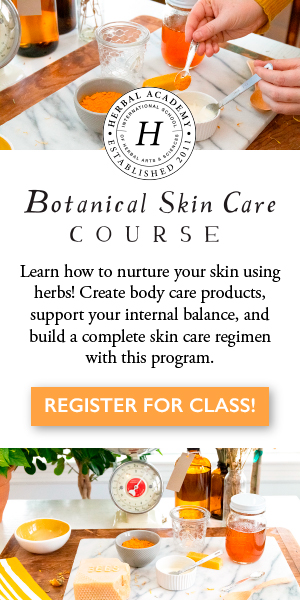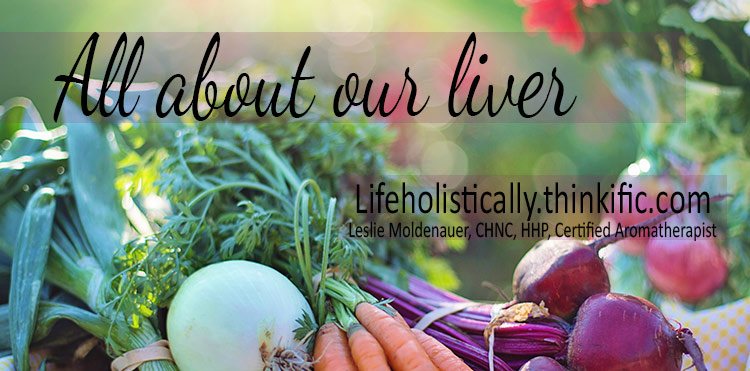
by Leslie Moldenauer | | Essential Oils
Do you feel overwhelmed when you hear how toxic our environment and therefore our bodies are, and hearing the latest buzzword of detox everywhere you turn, leaves you concerned and confused on the best possible plan of action if any? Determining Liver Health…
Over the last decade I’ve have trained and studied this very topic; and through a deep understanding of the detoxification systems of our body, I am excited to share all that I have learned.
While it is true that supporting our body in detoxification is important, the method of which to do so is oftentimes very misunderstood.
What you put in your body, and on your body is one determining factor of your overall health. Discover what nourishes you and your liver, and by making a few simple changes, learn how you can shift not only how you feel, but the function of your liver and much more!
I have taken all of my experience of more than a decade and placed them into a 3-part training series. The first is all about our liver, the second is the gut, and the third covers the biggest culprit of being unwell whether mentally, emotionally, or physically, which is stress.
Why did I choose these three together? They very much go hand in hand, like an intricate woven web. Each organ and system speak to each other, they help the other to function, in order for you to achieve optimal health.
Why this Training?
So, let’s briefly go over how the liver training will provide you with the insights, strategies, and tools for you to be well on your way to where you want to be:
*I provide plenty of easy to follow herbal recipes for optimal function of the liver, taking the guesswork out of the equation.
*Uncover the livers’ true role in detoxification, and what we can do in order to get it functioning like a well-oiled machine. Discover the food, nutrients, herbs, and mindset that will assist you with this.
*Do essential oils help to detoxify our liver? We will examine the real facts, and look at the research.
*Learn how the liver is tied to the health of almost every aspect of our body, and how we can easily have it singing our praises.
As a Mom who has made these changes, and works to keep my boys as healthy as I can, I speak your language. The change that comes about because you have a strong detoxification system is truly palpable.
Achieving this is easy, especially with the expertise I have to share with you, the knowledge both as a trained holistic health practitioner…. and as a Mom! I am incredibly passionate about helping all moms to embrace their health and mindset so that all cups are full to care for others. I want to help you to rock this beautiful life!
We are in this together. Let’s make self-care our health-care.
Click the link below to get started. There is a special launch rate for those in my group, Real Essential Oil Education until August 11th…be sure to check out the pinned post in the group for details!
Lifeholistically classroom on Thinkific!

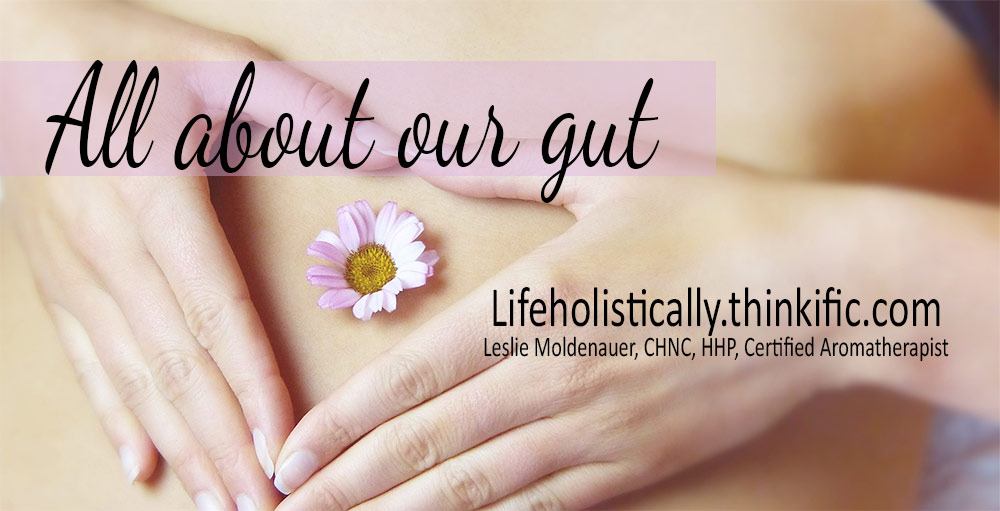
by Leslie Moldenauer | | Essential Oils
Are you at a point in your life where you want to make changes in how you eat to feed your body and mind, but you really do not know where to start? Determining our Gut Health…
Have you committed to starting, but it never happens? Does life get in the way?
I know exactly how you feel as I have been there myself. Over the last decade I’ve trained, studied and changed my diet as well as my mindset through real life easy to implement steps, and as a Mom who holds many plates in the air like you do, I want to share all that I have learned.
Just imagine not feeling bloated at the end of the day, in fact, imagine not having to change your clothes at night so you can be comfortable.
Discover what is not nourishing you, and how to make a shift not only in your wellness plan but also in your mindset!
Figure out exactly what it is that you are eating that is causing your gut the most distress, which is crucial to be able to heal.
Imagine…
Imagine… waking up in the morning vibrant and full of energy to do the things you want to do!
Imagine… that losing weight is not as hard as it once was!
Imagine…more solid moods because your gut is able to happily produce the feel-good hormones it is meant to!
These things are within your grasp…and I can help be your guide. I have taken all of my experience of more than a decade and placed them into a 3-part training series. The first is all about our liver, the second is the gut, and the third covers the biggest culprit of being unwell whether mentally, emotionally, or physically, and that is stress.
Why did I choose these three together? They very much go hand in hand, like an intricate woven web. Each organ and system speak to each other, they help the other to function, in order for you to achieve optimal health.
Why the training?
So, let’s briefly go over how the gut training will provide you with the insights, strategies, and tools for you to be well on your way to where you want to be:
*I provide plenty of easy to follow herbal recipes for healing the gut, taking the guesswork out of the equation.
*Uncover how to get your children’s digestion on track early, helping to limit the effects of common childhood ailments and diagnoses.
*Discover how your gut microbiota functions and what you can do to support it, as well as what to avoid that causes imbalance. Food, nutrients, herbs, and mindset will all be addressed.
*Do essential oils really help promote healthy bacteria in the gut? What does the research show?
*Learn why gut permeability (AKA leaky gut) is such a common issue. Many have it to some degree but are completely unaware!. What is it and what can we do about it?
*How is stress playing a role in the health of our digestive system? What are some options available to us to take our power back?
This portion of the three-part training comes with three printables to help you to take action! I held nothing back!
As a Mom who has made these changes, I speak your language. I understand what it’s like to make changes when you have a family, and I know that the change comes about because you have a happy gut!
Achieving that happiness is easy, especially with the expertise I have to share with you, the knowledge both as a trained holistic health practitioner…. and as a Mom! I am incredibly passionate about helping all moms to embrace their health and mindset so that all cups are full to care for others. I want to help you to rock this beautiful life!
Let’s make self-care our health-care!
Click the link below to get started. I am running a special launch rate until August 11 for those in my group, Real Essential Oil Education, hop on over there and join so you can get in on the discount.
Lifeholistically classroom on Thinkific!

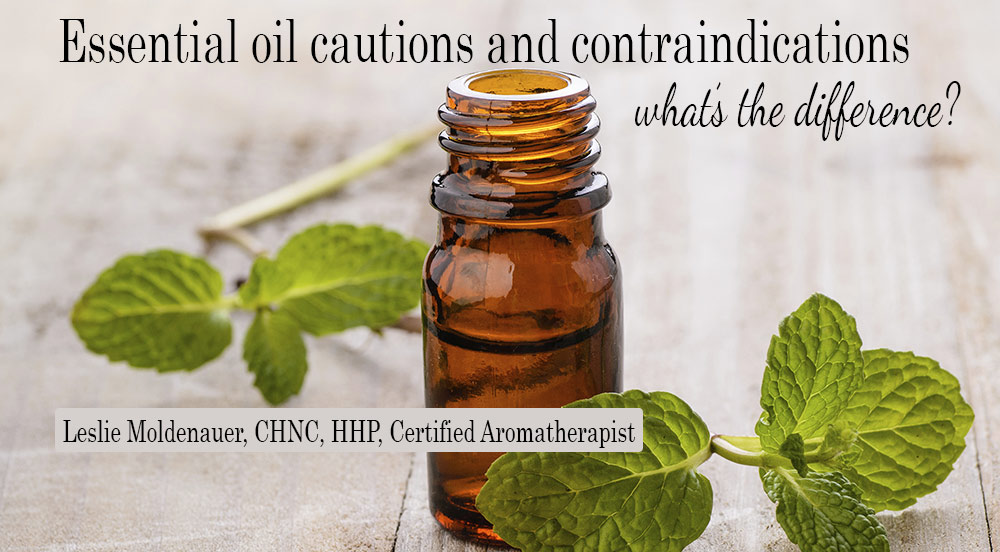
by Leslie Moldenauer | | Essential Oils
Essential Oil Safety-Cautions and Contraindications. This post is in response to a need/request from a poll in my Facebook group “Real Essential Oil Education Group”. The members asked for clarification about the differences between essential oil cautions and contraindications.
I had received an email back in April of 2017, asking me to state what I thought a caution and a contraindication meant in the aroma world.
He wanted to know what I thought the differences were. I am not sure if he thought I did not know (chuckle) or if he wanted to be sure I did. Those two things may seem similar, but I assure you at the moment they were very different considering the nature of the inquiry. This was my exact response, copy and paste from my response to him:
“Of course, happy to share my thoughts….
A contraindication is a situation, which makes a particular essential oil absolutely inadvisable. Of course, we know in “most”, but not all cases these contraindications are indicated via the oral pathway.
A caution or precaution is relating to an action taken to protect against possible harm/adverse effect if you will, in this case, avoid dermally under age two. In my practice, these would be more of a case-by-case basis, as sometimes the benefit does outweigh the risk. But this is not something I teach or share online for obvious reasons.
I would hope this is how most in the field understand it, but I am being generous. A quick Google search (my favorite) shows these two terms more often than not are interchangeable”.
This is the beginning of the issue I am afraid. Good Ol’ Dr. Google. A pervasive problem in so many areas, I actually wrote a blog specifically on that topic. But I digress.
When looking up the differences between a caution and a contraindication, even Google seems rather confused (said jokingly), people are confused. So, I thought I would go over it just a bit for you today.
These two terms should not be used interchangeably when it comes to essential oils just as much as herbs or pharmaceuticals.
*All examples below are from the book, Essential Oil Safety 2e written by Robert Tisserand and Rodney Young. (Get your copy here). None of the cautions or contraindications listed within is my own finding. My goal to close the gap on the many misunderstandings.
The book states that cautions are:
“potential hazards that do not warrant contraindications, either because the evidence is flimsy of because the hazard is not especially worrying”[1].
Cautions
Hypersensitive skin
Under age 2
Old/Oxidized oils should be avoided
(oral) Drugs metabolized by a particular cytochrome P450 pathway
(oral) Pregnancy
(oral) Specific medication
(oral) Peptic ulcer
(oral) GERD
(oral) Major surgery
This is not an all-inclusive list, but there are a few things to point out.
If this is a listed caution, it is ‘possible’ that there could be an issue when used in this manner.
- For example, you could utilize an essential oil that is listed as a caution under the age of 2, like lemongrass (Cymbopogon flexuosus), for example. Is it off limits? No. Should we be educated and know the risk, and work to minimize risk? Absolutely.
- Another example would be (oral) GERD, as is the case with Peppermint (Mentha piperita) essential oil. Can you take peppermint in this manner? You can. Is there an increased likelihood to have gastroesophageal irritation and heartburn from it? There is. But, if taken responsibly, such as in an enteric coated capsule over something not recommended like dropping peppermint essential oil in water and drinking it, will go a long way in reducing the risk from said caution.
- Old/oxidized oils should be avoided. It can be challenging to determine if an essential oil has oxidized. If you apply an oxidized essential oil properly diluted to the skin, you ‘may’ have a reaction…and you may not. This is not a statement to encourage you to do this, it is just stating that it should be avoided if at all possible to eliminate the risk from said caution.If we can eliminate risk, we should right? But, reality check…..in aromatherapy, there is a risk. Some small, some not so small….and it is an aromatherapists job to first and foremost be able to analyze any risk…and look for ways to lower it. Eliminating it all together is in many cases not possible. Now let’s look at contraindications.
The book further states that contraindications are:
“When the oil should be avoided. The method of administration is also stated. Oral contraindications apply to the oral of administration of essential oils as used in aromatic medicine. Oral contraindications do not apply to the use of essential oils and any other context, such as in foods, fragrances, personal care products or by inhalation” [2].
Contraindications
(all routes) Do not apply on or near the face of infants or children
(all routes) Anticoagulant medication
(all routes) Pregnancy
(all routes) Children
(all routes) Estrogen-dependent cancers
(oral) Cholestasis
- The first example here with contraindications is a popular one, and that is an essential oil high in 1,8 cineole should be avoided (is contraindicated) on or near the face of infants and children. This does not mean no, never, it means never near the face. Responsible diffusion may be perfectly ok.
- Pregnancy contraindications, when listed as (all routes). The benefit does not outweigh the risk, it should be avoided for all routes of application: topical, inhalation, or oral, period.
A couple of important points to remember:
*If a contraindication states (oral) in the book, this does not mean that the oil needs to be avoided topically or via inhalation.
*Remember, cautions are a ‘potential chance’ of an issue. There are many essential oils that are cautioned under the age of 2 dermally/topically. This does not then mean it cannot be inhaled.
Some may see this information as cut and dry, while others still need further clarification. There is nothing wrong with being overly cautious, and many professionals are. We all come to the table with varying levels of experience so this is expected.
If I ever find myself in a position where I am taking a caution a step further than Tisserands recommends I typically say “The research states X, but in your situation, I am not comfortable making that recommendation because of Y”. I try to always stay true to what we do know, not make my own rules, but I am willing to step outside of the box when my education and experience tells me the situation warrants it.
I am a stickler about using the verbiage above in order to not cause confusion on what we do know about cautions, contraindication, and hazards….and explain things as thoroughly as I can.
I hope that this helps to clear up any possible confusion that a ‘caution’ often brings up. If you need further clarification, I invite you to reach out to me in the group (request to join), or simply email me at Lifeholistically@gmail.com
References
[1] [2] Tisserand, R., Young, R., & Williamson, E. M. (2014). Essential oil safety: A guide for health care professionals. Edinburgh: Churchill Livingstone/Elsevier.
Like so many practices in life, I encourage you to become educated on the proper use of essential oils. When using them, please do so cautiously, understanding that there is often misinformation on the internet. You can be assured that I support only educated and proven resources. While essential oils should not be feared they should be respected and used properly to ensure the safety of the individuals using them.
Please note that I am not a medical practitioner. The content of this website is provided for general informational purposes only and is not intended as, nor should it be considered a substitute for, professional medical advice. Do not use the information on this website for diagnosing or treating any medical or health condition. If you have or suspect you have a medical problem, promptly contact your professional healthcare provider. By using this website, you assume full responsibility and liability for your own actions.
What is an Adverse Reaction to an Essential Oil?
Find Your Footing Using Natural Remedies
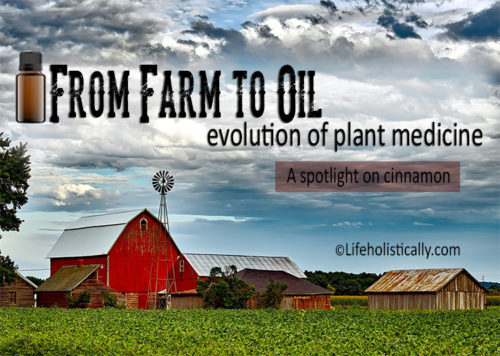
by Leslie Moldenauer | | Essential Oils
The essential oils that we know and love are derived from plants, but this does not necessarily mean that the therapeutic benefits or uses from the plant to essential oil are the same. In many cases, this does not hold true. There are many recipes online utilizing essential oils that do not honor chemistry, and do not focus on safe use. Essential oil sustainability is also a massive concern as more and more people are stepping into the essential oil community every day. It is not necessary to use oils every day, or in everything. When we see a recipe shared online, we must ask ourselves if it is necessary, shifting the way we currently see these beautiful resources. Today my focus is on cinnamon essential oil: From Farm to Oil:Evolution of Plant Medicine-A Spotlight on Cinnamon
My goal in this series of blogs is to celebrate plants in all of their glory. I will walk you through from farm to oil. Uses, limitations, and fun recipes of each botanical will be covered. Within each article I will discuss the herb, flower, fruit, seed, root, or bark, and finally, the oil. This will be informative and most importantly, FUN!
Today is all about Cinnamon. I will be covering the spice and in regards to the essential oil, will be looking at both Cinnamon bark (Cinnamomum zeylanicum) and Cinnamon leaf (Cinnamomum verum), the botanical names are sometimes used interchangeably, but the chemistry, cautions, and contraindications are different.
Cinnamon
Cinnamon is a spice that comes from the branches and bark of wild trees that belong to the genus “Cinnamomum”.
Cinnamon might not be the first spice that we reach for when cooking a meal, but it is definitely not due to a lack of health benefits.
There are two main types of cinnamon [1]. Ceylon cinnamon is the first, and is sometimes called “true” cinnamon. The other is Cassia cinnamon. Cassia is the more common variety today, and contains more Coumarin than the Ceylon variety. Coumarin is a very important constituent that I will be covering in more detail when I dig into the essential oils.
**Side note, there is overly processed cinnamon spice on the market that lacks therapeutic value, so be sure that you buy yours from a reputable supplier. Contrary to what you have read online, there is not a truly ‘fake’ cinnamon, just inferior ones.
As with any other herb that you purchase, the fresher it is the better. When cinnamon loses its bite, it also starts loosing its therapeutic value.
Cinnamon is rich in plant polyphenols that can help control blood sugar and insulin spikes after meals [2]. Adding a pinch to your tea before a meal is a fantastic way to find balance. Polyphenols are antioxidants that come with many benefits, and have many studies attached to them. One placebo-controlled trial found that a supplement containing cassia cinnamon, chromium and carnosine successfully lowered fasting blood sugar in people with pre-diabetes [3].
Blood sugar balance is not the only benefit that cinnamon provides us. A study published in 2003 by the journal Diabetes Care showed that cinnamon reduces patients’ triglycerides, and LDL cholesterol in patients with type 2 diabetes, lowering the risk factors associated with diabetes and cardiovascular diseases [4]. These results were measured after anywhere from 1-6 grams of the spice was taken internally for 40 days.
These are just a few examples of why consuming cinnamon spice daily may have some benefits to your overall health.
WebMD states that cinnamon is considered to be safe when consumed in the levels you would in food. Consuming in large amounts could be a concern for those with blood clotting issues or those on blood thinning medications due to the constituent Coumarin. Use caution if you have been diagnosed with low blood sugar levels (hypoglycemia), as cinnamon has been shown to have the ability to lower it further it could cause issues for you [5].
If the above cautions do not apply to you, I ask that all of you begin to think about where you can use the spice before reaching for the essential oil, as the benefits are often not the same. Here are a few ideas for you.
Cooking with Cinnamon
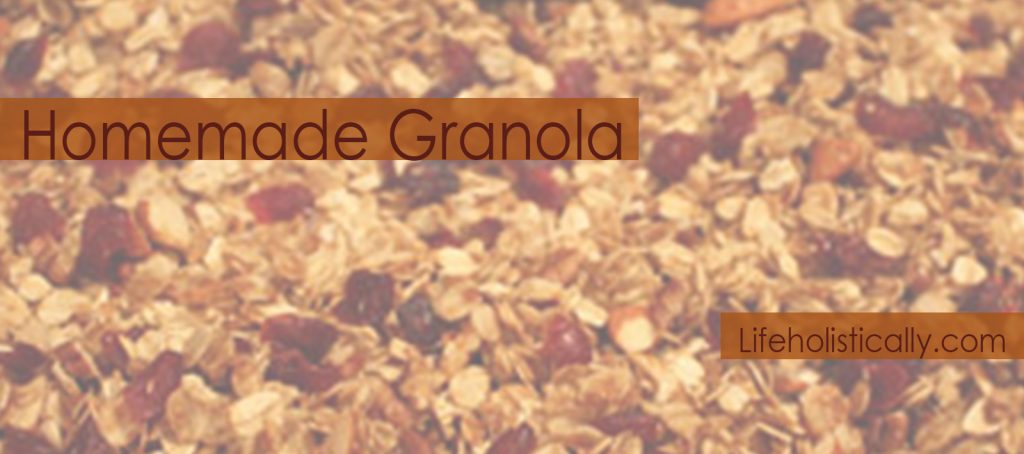
Pumpkin Cinnamon Granola
Ingredients:
Organic pumpkin puree 1/2 cup
Pure honey 1/3 cup
Pure vanilla extract 1 teaspoon
Gluten free oats 2 1/2 cups
Chia seed 1/4 cup
Pecans, Walnuts, or Almonds ½ cup crushed
Pumpkin seed 1/4 cup
Dried cranberries 1/2 cup
Himalayan pink sea salt 1 tsp
Ground cinnamon 2 tsp
Ground ginger 1/2 tsp
Ground nutmeg 1/4 tsp
Directions:
Preheat the oven to 300 degrees F. Line a baking sheet with parchment paper.
In a large bowl, mix the pumpkin puree, cinnamon, ginger, salt, and nutmeg. Stir in the honey and vanilla extract. Next, add the oats and quinoa, and stir until evenly coated. Lastly, add the crushed nuts and pumpkin seeds.
Spread the mixture evenly on the parchment paper and press down with the back of a spatula. Bake for 20 minutes, gently mix, then bake for an additional 20 minutes. Place the pan on a wire rack and let the granola cool completely on the baking sheet for a minimum of one hour. Once cool add the cranberries.
This recipe will keep in an airtight container at room temperature for 2-3 weeks. Add to your favorite yogurt, pour over almond milk, or eat plain to assist in balancing blood sugar between meals.
Morning Cinnamon Smoothie
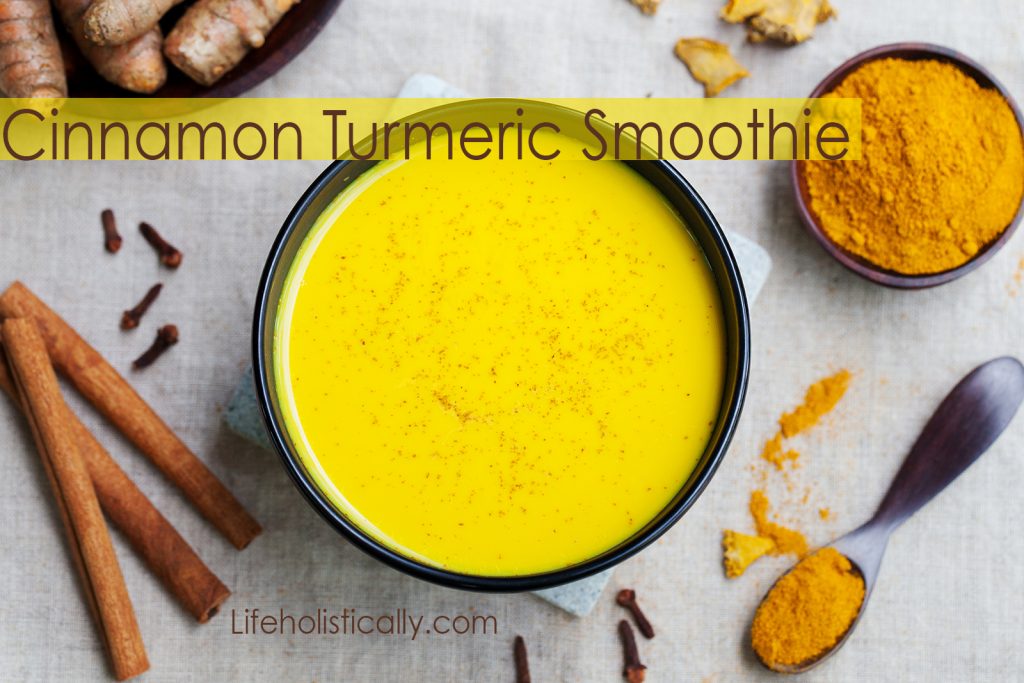
Ingredients:
Unsweetened almond milk 12 oz (can replace with coconut milk)
Half of a frozen banana
Organic pitted dates 2 chopped
Ground cinnamon 2 tsp
Ground turmeric 1 tsp
Blend well and enjoy!
Using the Spice in Body Recipes
Ground cinnamon can be quite heavenly in a body scrub; it is aromatic and helps to open the sinuses giving you a pep in your step to start off your day. I prefer the spice to the essential oil on the skin, as the oil has a much higher risk of skin irritation. More on this shortly
Cinnamon Body Scrub
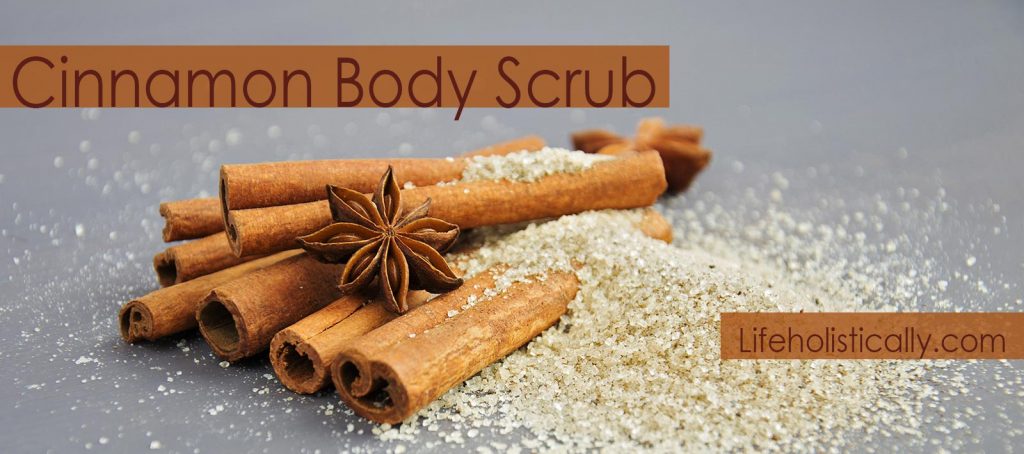 Ingredients:
Ingredients:
Brown sugar 1 cup
Coffee grounds 2 tbsp
Carrier oil of your choice 1/4 cup
Ground cinnamon 1 tsp
Ground nutmeg 1/4 tsp
Mix well and store in a glass container. Make sure you do not dip wet fingers into the container; the introduction of water into the container will encourage microbial growth.
Cinnamon Essential Oil
Cinnamon bark (Cinnamomum zeylanicum)
Cinnamon bark is a powerful aromatic oil, and contains high amounts of the constituent cinnamaldehyde. As is the case with aldehydes, cinnamon bark essential oil carries a very high risk for skin irritation, the highest of almost any essential oil in the marketplace. Robert Tisserand gives more details on the skin risk here.
Tisserand recommends not using on the skin at rates any higher than 0.1%. These numbers are very important when you look at it in a blend. This is what it would look like:
5mls carrier oil=0.1 drops cinnamon bark
50mls carrier oil=1 drop cinnamon bark
50mls is the equivalent of approximately 1.75 ounces/3.5 tbsp/10tsp
Due to this, I have great concern for those purchasing proprietary anti-germ blends containing cinnamon bark essential oil. There is no way to know if the blend is safe to use on the skin or not. Couple that with individuals recommending applying these blends neat or undiluted….it is simply playing with fire.
According to Tisserand, cinnamon bark essential oil should be avoided is pregnant or nursing, and can be risky for anyone attempting to take it orally with numerous medications, which I highly discourage.
Diffusing it even comes with precautions. You can burn the inside of the nose or irritate the lungs if you sit too close.
For these reasons, I do not use cinnamon bark in my practice or in my home.
For a detailed list of cautions and contraindications for cinnamon bark, refer to Tisserand’s, Essential Oil Safety 2e.
Cinnamon leaf (Cinnamomum verum)
Cinnamon leaf does not comes from the bark like its counterpart, but it still carries cautions. There are some professionals that consider cinnamon leaf to be a safe replacement for cinnamon bark, and it can be.
First things first, cinnamon leaf has high amounts of eugenol, which is in the family of phenols. Phenols are considered caustic, so we still need to use great care when applying to the skin. Can it be used on the skin at all? It can. Cinnamon leaf is most used in a blend for muscle tightness and discomfort. Even though there are many other essential oils that are useful for discomfort, I highly recommend using the leaf over the bark.
When looking at the figures above for cinnamon bark, that only 1 drop is recommended in 50mls of carrier oil, in comparison you can go up to 7 drops of cinnamon leaf in 50mls of carrier oil.
There are many cautions and contraindications to both cinnamon bark and cinnamon leaf essential oils. According to Tisserand, Cinnamon leaf had many of the same concerns as cinnamon bark. Are you asking why I do not utilize cinnamon leaf if I can? When looking at the range of essential oils that are available to me in my toolbox, I would rather go with essential oils that are effective without all the risk of irritation.
For more information, refer to Tisserand’s Essential Oil Safety 2e.
I have included a number of references should you want to do additional research on both cinnamon bark and cinnamon leaf. If you are currently using either in hopes of ‘staying well’, I encourage you to comb through them.
Closing
When we take from the earth for nutrition, sustenance, and healing, it is important that we always consider not only the impact of our use but on giving back. In an ideal world, if we all gave back a little bit more than we take, the impact would be massive. As you can see here with cinnamon, the essential oil carries much more risk than the spice. With so many people utilizing these essential oils, there is great concern for injury. For the continued future success of natural healing, it is important that we look at the big picture by looking at risk vs benefit. I hope you can see that here the risk is far greater.

Like so many practices in life, I encourage you to become educated on the proper use of essential oils. When using them, please do so cautiously, understanding that there is often misinformation on the internet. You can be assured that I support only educated and proven resources. While essential oils should not be feared they should be respected and used properly to ensure the safety of the individuals using them.
Please note that I am not a medical practitioner. The content of this website is provided for general informational purposes only and is not intended as, nor should it be considered a substitute for, professional medical advice. Do not use the information on this website for diagnosing or treating any medical or health condition. If you have or suspect you have a medical problem, promptly contact your professional healthcare provider. By using this website, you assume full responsibility and liability for your own actions.
References
[1] History behind cinnamon. Retrieved from https://blog.paleohacks.com/ceylon-cinnamon/
[2] Bozzetto, L. et.al. Polyphenol-rich diets improve glucose metabolism in people at high cardiometabolic risk: a controlled randomised intervention trial. Diabetologia 2015 Jul;58(7):1551-60
[3] liu, Y. et.al (2015) A Dietary Supplement Containing Cinnamon, Chromium and Carnosine Decreases Fasting Plasma Glucose and Increases Lean Mass in Overweight or Obese Pre-Diabetic Subjects: A Randomized, Placebo-Controlled Trial. PLOS One. Sep 25;10(9):e0138646
[4] Cinnamon improves glucose and lipids of people with type 2 diabetes. Retrieved from https://www.ncbi.nlm.nih.gov/pubmed/14633804
[5] Cassia cinnamon. Retrieved from https://www.webmd.com/vitamins/ai/ingredientmono-1002/cassia-cinnamon
Resources
Cinnamon bark. https://www.webmd.com/vitamins/ai/ingredientmono-330/cinnamon-bark
6 Side Effects of Too Much Cinnamon. https://www.healthline.com/nutrition/side-effects-of-cinnamon
12 Side Effects of Cinnamon. https://www.cinnamonvogue.com/cinnamon_side_effects.html
BEFORE YOU GO! Remember to sign up for my FREE Facebook group! Hang out with me and THOUSANDS of other Essential Oil lovers looking to learn, click on to join Real Essential Oil Education Group!
Check out my FREE offer below!
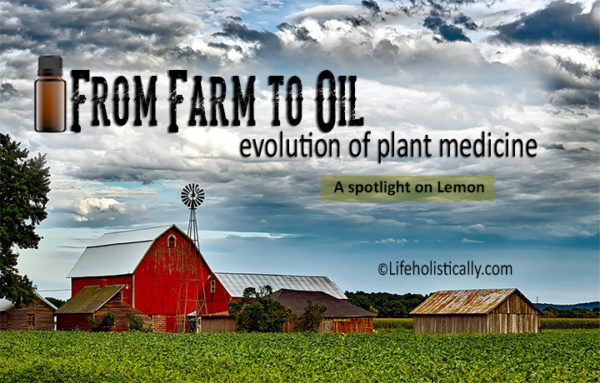
by Leslie Moldenauer | | Essential Oils
The essential oils that we know and love are derived from plants, but this does not necessarily mean that the therapeutic benefits or uses from the plant to essential oil are the same. In many cases, this does not hold true. There are many recipes online utilizing essential oils that do not honor chemistry and do not focus on safe use. Sustainability is also a massive concern as more and more people are stepping into the essential oil community every day. It is not necessary to use oils every day, or in everything. When we see a recipe shared online, we must ask ourselves if it is necessary, shifting the way we currently see these beautiful resources. From Farm to Oil: Evolution of Plant Medicine-A Spotlight on Lemon
My goal in this series of blogs is to celebrate plants in all of their glory. I will walk you through from farm to oil. Uses, limitations, and fun recipes of each botanical will be covered. Within each article, I will discuss the herb, flower, fruit, seed, root, or bark, and finally, the oil. This will be informative and most importantly, FUN!
Lemons, Juicy and Sweet…. (Citrus limon)
The top 5 places in the world where lemons are grown (primarily) are India, Argentina, Spain, and the US (California and Arizona) [1]. When looking at the production of lemons worldwide, the amount of lemons that are grown organically is negligible.
What should we know about conventionally grown lemons? They are sprayed with a lot of pesticides. The pesticides include Imazalil, Thiabendazole, and Sodium O’Phenylphenate (aka Orthophenylphenate), which are all toxic carcinogens as well as endocrine disruptors [2] [3] [4].
So my first very important point in regards to lemons as whole, fruit or essential oil…buy organic. It really is worth the additional cost.
Limonene
The main constituent in a lemon that we look to use for our health is limonene. Limonene has many benefits, and there have been many studies involving this constituent that shows that it does, in fact, have great promise. Limonene is found in the peel of the citrus fruit. Citrus essential oils are either steam-distilled or cold-pressed and will contain a high amount of limonene.
Now, before your mind goes down the rabbit hole, as you can easily find misinformation online in regards to lemon essential oil, we need to address the method of use from fruit to oil, as that oftentimes is where the message gets lost in translation when it comes to this juicy fresh citrus fruit.
Antioxidants
We all want to obtain antioxidants in our diets. Antioxidants devour free radicals. Now, it is important to understand that if we are breathing oxygen, we are creating free radicals, so reality is important too. So…free radicals…in small quantities, not a huge concern, but in excess they will accelerate aging and can lead to all sorts of negative health problems. And since we are being bombarded from all sides with pollution of some sort, we need our liver performing optimally at all times. Consuming foods rich in antioxidants will go a long way towards your optimal health.
Enter lemons, which are very rich in antioxidants, due to both the limonene content as well as the vitamin C content. Thoroughly washing your organic lemons and placing a slice in your water every day is quite healthy, or go one step further. Use the juice of a ½ a lemon in a tall glass of water and you have obtained 25% of your recommended daily allowance (RDA) of vitamin C [5]. Did you think one step further meant place the essential oil in your water? Well, you will never hear that advice from me, more on that shortly. Just remember to take care of the enamel on your teeth if you drink lemon juice in your water daily, as lemons are very acidic in nature. Rinsing well with water after your drink is a good precautionary measure.
Using the Fruit
Want a sweet treat without the guilt? This is a perfect summery treat, one that a friend recommended I try when she saw a bowl of organic lemons on my counter.
Raw Lemon Meltaways
Makes about a dozen (unless you opt for the larger silicone cups)
*I usually triple this recipe and keep some in the freezer
Adapted from DETOXINISTA
Ingredients:
Raw cashew butter 1/2 cup
Freshly squeezed lemon juice 3-4 tablespoons
Raw honey 2 tablespoons
Coconut oil, melted 3 tablespoons
Pinch pink Himalayan sea salt
Lemon zest from the fresh squeezed lemon 2 teaspoons
Mini paper baking cups (I prefer these silicone cups)
Directions: Mix until smooth and creamy and pour evenly into baking cups on flat cookie sheet. Sprinkle the zest over the top. Place in freezer for 30-45 minutes. Serve frozen, they will ‘melt’ at room temperature.

Lemon Strawberry Mint Popsicles
Adapted from LiaGriffith
These molds are just perfect, and BPA free
Warm water 1 cup
Cold water 1 cup
Raw honey 1/2 cup
Mint leaves, 5-6 sliced in thin strips
Lemon juiced 1
Strawberries, thinly sliced
Warm one cup of your water on the stove to melt the raw honey. Add to a stainless steel or glass bowl to cool quickly (add a few pieces of mint to the warm water). When cooled, add the rest of the water and lemon juice.
Place the strawberry slices and mint evenly in your molds, and pour your liquid mixture in. Freeze.
These are so incredibly delicious, without the unhealthy sugars or food coloring.
I encourage you begin to think more about where you can use the nutrient dense fruit before reaching for the essential oil.
When the Essential Oil is Helpful
We can utilize the essential oil to bounce back from illness much quicker alongside quality nutrition, hydration, and rest. Try this blend in a diffuser:
Immune Strong
Lemon (Citrus limon) 5 drops
Palmarosa (Cymbopogon martini) 3 drops
Tea Tree (Melaleuca alternifolia) 1 drop
Lavender (Lavandula angustifolia) 1 drop
This amount of drops is suitable for a 400ml water reservoir diffuser. Adjust accordingly for your diffuser.
Citrus Burst Foaming Hand Soap (Approximately 1.5% dilution)
When looking at formulating hand soap, there is a safe way and an unsafe way. If you do not add some type of preservative, you will grow mold and other nasties in your pump bottle. I like to be crunchy and green whenever possible, but safety can easily trump that in specific cases. This is one of these cases.
In a foaming pump bottle (8 oz), fill halfway with distilled water (always add the water before the soap). Next add castile soap, leaving a good inch at the top of the bottle, you’ll need to leave ample space to put on pump top without causing spillage.
Now add:
Lemon Steam-distilled (Citrus limon) 30 drops
Orange sweet (Citrus sinensis) 25 drops
Mandarin red (Citrus reticulate) 15 drops
Carrier oil of your choice ½ teaspoon (helps to emulsify and prevent skin drying)
AMTicide® Coconut [6] Preservative 1 teaspoon
Cover and shake. This smells amazing, will not leave your hands dry, but will leave them clean and germ-free, safely.
Smell the Lemon
The smell of lemon is so incredibly uplifting, so much so that it is an oil of choice (one of a few) in oncology departments to improve quality of life, and to greatly reduce anxiety in patients. This is done in a professional setting, where the essential oils are treated just like medicine, as that is what they are. If you would like to read the study, I have uploaded it so that you can read it in full here.
To be frank, this shows us that essential oils are being used in a hospital setting as complementary care, not a cure for cancer that is shared so often in social media. There have been promising studies in Petri dishes, outside of the human body (in vitro), which is definitely promising. I hope the future is bright in this area, but the reality is, we are not there yet.

Lemon Essential Oil Misconceptions
There are two really big misconceptions that I want to briefly talk about, and provide resources for further reading.
The first ‘myth’ is stating that we can and should be placing drops of lemon essential oil in our water to drink daily. Some suggest a drop, some much more. Is this really logical?
Essential oils are lipophilic, also called non-polar substances, but they are not actually fats. Water, on the other hand, is polar [7]. When looking at things from a chemistry angle, when you have one non-polar substance and one polar substance, it is like a bad date, they cannot get away from each other quickly enough. They stay separate, trying adamantly not to touch. Unlike the dating scene, opposites do not attract here. The oils will sit on top of the water, no matter how vigorously you mix it, or the temperature of the water. Chemistry is chemistry. Learn more about essential oil chemistry, here.
Many people are drinking their essential oils, and this is very unfortunate, as the risk is not fully understood. Why? Long-term studies are not yet available. The reason is that this is a relatively new recommendation, albeit a very prevalent one, so I feel the evidence will begin to show itself in time. In the meantime, are you willing to be part of the experiment?
I firmly stand by the fact that essential oils do not belong in a glass of water without an emulsifier, period.
The second misconception and the reason why it is stated to put essential oils in our glass of water is that essential oils contain nutrients, in the case of Lemon, the claim is often vitamin C.
According to the Oxford Dictionary, a nutrient is “A substance that provides nourishment essential for the maintenance of life and for growth” [8].
The Oxford Dictionary further states that a supplement is “A substance taken to remedy the deficiencies in a person’s diet” [9].

A few key points in regards to this topic are:
1. Steam distillation of plant matter occurs at approximately 100 °C/212 °F [10].
2. Vitamins degrade at very specific temperatures. Vitamin C, for example, degrades right around 70 °C [11]. Notice that this is 30° cooler than the temperature in which plants are distilled.
3. Lemon essential oil is not providing us with anything that we are missing from our daily diet (since there is no Vitamin C present), therefore is not a supplement.
What about the cold-pressed variety you ask? Because the cold pressed variety of essential oil is not performed under heat, it is fair to say that some vitamin C could be present in the oil, although evaporation of the volatile nutrient will definitely come into play here are well. It is very important to remember though, the amounts will be insignificant, definitely not anything to write home about. If you are looking to obtain vitamin C as a true supplement, please consider the fruit.
I know that these are only bits and pieces of a very important puzzle, therefore, I ask that you please take the time to read my detailed article on essential oils and nutrients, here.
Closing
When we take from the earth for nutrition, sustenance, and healing, it is important that we always consider not only the impact of our use but on giving back. In an ideal world, if we all gave back a little bit more than we take, the impact would be massive.
If you are placing lemon essential oil in your water every day, think first and foremost of the possible health implications of this. Always use a critical eye to consider what you were previously told may be flawed. Is further unbiased research needed on your part? Are using these resources every day in this manner supportive of the sustainability of essential oils? Could we utilize the real fruit for a much safer, nutrient-rich alternative? I think the answer to this is a resounding YES!
We need to begin to shift the way we currently see these beautiful resources, for the continued future success of natural healing.

Like so many practices in life, I encourage you to become educated on the proper use of essential oils. When using them, please do so cautiously, understanding that there is often misinformation on the internet. You can be assured that I support only educated and proven resources. While essential oils should not be feared they should be respected and used properly to ensure the safety of the individuals using them.
Please note that I am not a medical practitioner. The content of this website is provided for general informational purposes only and is not intended as, nor should it be considered a substitute for, professional medical advice. Do not use the information on this website for diagnosing or treating any medical or health condition. If you have or suspect you have a medical problem, promptly contact your professional healthcare provider. By using this website, you assume full responsibility and liability for your own actions.
References
[1] Lemon Growing in the Florida Home Landscape. Retrieved from http://edis.ifas.ufl.edu/hs402
[2] Imazalil http://www.pesticideinfo.org/Detail_Chemical.jsp?Rec_Id=PC33040#Toxicity
[3] Thiabendazole http://www.pesticideinfo.org/Detail_Chemical.jsp?Rec_Id=PC34581#Toxicity
[4] O-PHENYLPHENATE http://scorecard.goodguide.com/chemical-profiles/summary.tcl?edf_substance_id=132-27-4
[5] Benefits of drinking lemon water. Retrieved from https://www.medicalnewstoday.com/articles/318662.php
[6] AMTicide® Coconut. Retrieved from http://www.lotioncrafter.com/amticide-coconut.html
[7] Polar vs Non-Polar Molecules: What you Need to Know. Retrieved from https://blog.udemy.com/polar-vs-non-polar/
[8] Definition of a Nutrient. Retrieved from https://en.oxforddictionaries.com/definition/nutrient
[9] Definition of a Supplement. Retrieved from https://en.oxforddictionaries.com/definition/supplement
[10] Distilling Aromatic Plants. Retrieved from https://aromaticstudies.com/distilling-aromatic-plants/
[11] Rahmawati, S., Bundjali, B. Kinetics of the Oxidation of Vitamin C. Retrieved from http://www.researchgate.net/publication/228484005_KINETICS_OF_THE_OXIDATION_OF_VITAMIN_C
Resources
Sustainability Issues https://naha.org/explore-aromatherapy/sustainability-issues/
The Environmental Impact of Essential Oils http://www.earthisland.org/journal/index.php/elist/eListRead/the_environmental_impact_of_essential_oils/
BEFORE YOU GO! Remember to sign up for my FREE Facebook group! Hang out with me and THOUSANDS of other Essential Oil lovers looking to learn, click on to join Real Essential Oil Education Group!
Check out my FREE offer below!
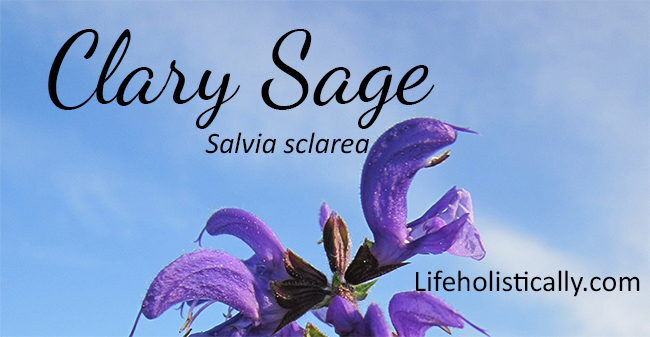
by Leslie Moldenauer | | Essential Oils
I have received this question quite a bit lately, so I decided to publish a short article giving my professional opinion in regards to essential oils during pregnancy, labor, and delivery. I addressed this a bit in another article but thought it bears repeating. Essential Oil Safety-Using Clary Sage During Labor & Delivery
I have been asked if there is anything that can be used to move labor along. What I consider moving labor along is not the same as how the question is usually intended. You can use essential oils to keep yourself calm, to keep the body from tensing and being overly-stressed, and by doing this, labor progresses nicely. The goal of essential oils should not be to induce or increase the intensity of your contractions or move labor along. This is not recommended. I have the same opinion of Pitocin. If this medication can be avoided, avoid it. Pitocin can cause problems such as intensified rapid contractions, so intense that both baby and mom can potentially become very distressed, increasing the need for medical interventions. I do understand that sometimes things are out of your control; so, do not beat yourself up about the way things progress in the delivery room. However, if you are able to pull it off, a natural birth is ideal. Here is a great article that talks about the pros as well as the cons of Pitocin; non-biased information is always best [1].
Clary sage (Salvia sclarea) is an essential oil that is touted for starting labor. Unless you are working with a qualified clinical aromatherapist, do not use essential oils with this intention. Please let your body do what it knows to do, in its time. This does not mean, however, that clary sage needs to stay out of the birthing room.
Once labor is underway and contractions are regular, clary sage can be used safely in an inhaler to calm, with little potential for harm. I hope you can now differentiate between timing and wanted outcome.
You will find varying opinions on the Internet and in social media regarding whether essential oils are safe during pregnancy, labor, and delivery. Be sure to question the training and experience of anyone who has written a book or blog on a serious topic such as this. Aromatherapy and the use of essential oils are not regulated in the United States, so a license or degree is not required to give you and your family advice. During this special time of your life and the birth of your child, you will want to consult with a well-trained and qualified aromatherapist.
According to Jane Buckle Ph.D., RN, who is a very well respected aromatherapist, and founder of the American Holistic Nurses Association, aromatherapy is in fact very safe when you are well-versed in its safety and use. Aromatherapy has been used for years in a clinical setting without known harm to mom, infant or fetus [2]. Buckle has taught nurses all over the world how to safely use essential oils in their clinical practice. I can’t stress this enough, do not pick up a random book or blog on essential oils for the birthing room. If you are unsure and would really like to explore the possibilities of using aromatherapy for you and your family, please reach out to a qualified aromatherapist.
Like so many practices in life, I encourage you to become educated on the proper use of essential oils. When using them, please do so cautiously, understanding that there is often misinformation on the internet. You can be assured that I support only educated and proven resources. While essential oils should not be feared they should be respected and used properly to ensure the safety of the individuals using them.
Please note that I am not a medical practitioner. The content of this website is provided for general informational purposes only and is not intended as, nor should it be considered a substitute for, professional medical advice. Do not use the information on this website for diagnosing or treating any medical or health condition. If you have or suspect you have a medical problem, promptly contact your professional healthcare provider. By using this website, you assume full responsibility and liability for your own actions.
References
[1] Pitocin Induction: The Risks and Benefits.
[2] Tillett, J., Ames, D. (2010) The uses of aromatherapy in women’s health. Journal of Perinatal & Neonatal Nursing. Vol. 24, No. 3, (pp. 238-245)
Resources
Essential Oils During Labor and Delivery
How to Prepare for Motherhood, Taking Best Care of Self
Prenatal and Postnatal Care for Mothers
Essential Oils, Uncovering Fact From Fiction
BEFORE YOU GO! Remember to sign up for my FREE Facebook group! Hang out with me and THOUSANDS of other Essential Oil lovers looking to learn, click on to join Real Essential Oil Education Group!
Check out my FREE offer below!








 Ingredients:
Ingredients:






